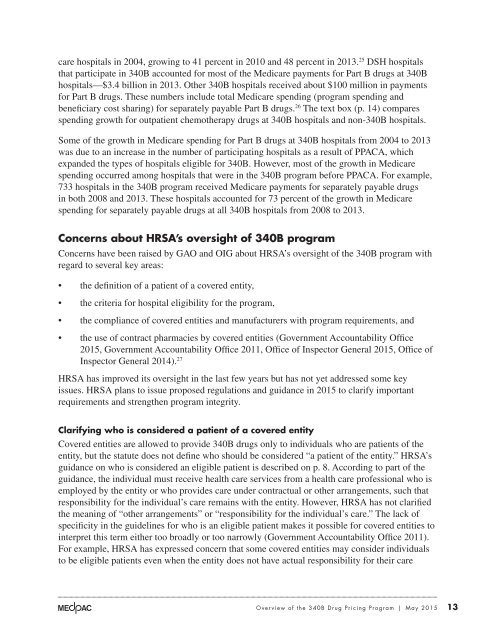Overview of the 340B Drug Pricing Program
1Mmfbin
1Mmfbin
Create successful ePaper yourself
Turn your PDF publications into a flip-book with our unique Google optimized e-Paper software.
care hospitals in 2004, growing to 41 percent in 2010 and 48 percent in 2013. 25 DSH hospitals<br />
that participate in <strong>340B</strong> accounted for most <strong>of</strong> <strong>the</strong> Medicare payments for Part B drugs at <strong>340B</strong><br />
hospitals—$3.4 billion in 2013. O<strong>the</strong>r <strong>340B</strong> hospitals received about $100 million in payments<br />
for Part B drugs. These numbers include total Medicare spending (program spending and<br />
beneficiary cost sharing) for separately payable Part B drugs. 26 The text box (p. 14) compares<br />
spending growth for outpatient chemo<strong>the</strong>rapy drugs at <strong>340B</strong> hospitals and non-<strong>340B</strong> hospitals.<br />
Some <strong>of</strong> <strong>the</strong> growth in Medicare spending for Part B drugs at <strong>340B</strong> hospitals from 2004 to 2013<br />
was due to an increase in <strong>the</strong> number <strong>of</strong> participating hospitals as a result <strong>of</strong> PPACA, which<br />
expanded <strong>the</strong> types <strong>of</strong> hospitals eligible for <strong>340B</strong>. However, most <strong>of</strong> <strong>the</strong> growth in Medicare<br />
spending occurred among hospitals that were in <strong>the</strong> <strong>340B</strong> program before PPACA. For example,<br />
733 hospitals in <strong>the</strong> <strong>340B</strong> program received Medicare payments for separately payable drugs<br />
in both 2008 and 2013. These hospitals accounted for 73 percent <strong>of</strong> <strong>the</strong> growth in Medicare<br />
spending for separately payable drugs at all <strong>340B</strong> hospitals from 2008 to 2013.<br />
Concerns about HRSA’s oversight <strong>of</strong> <strong>340B</strong> program<br />
Concerns have been raised by GAO and OIG about HRSA’s oversight <strong>of</strong> <strong>the</strong> <strong>340B</strong> program with<br />
regard to several key areas:<br />
• <strong>the</strong> definition <strong>of</strong> a patient <strong>of</strong> a covered entity,<br />
• <strong>the</strong> criteria for hospital eligibility for <strong>the</strong> program,<br />
• <strong>the</strong> compliance <strong>of</strong> covered entities and manufacturers with program requirements, and<br />
• <strong>the</strong> use <strong>of</strong> contract pharmacies by covered entities (Government Accountability Office<br />
2015, Government Accountability Office 2011, Office <strong>of</strong> Inspector General 2015, Office <strong>of</strong><br />
Inspector General 2014). 27<br />
HRSA has improved its oversight in <strong>the</strong> last few years but has not yet addressed some key<br />
issues. HRSA plans to issue proposed regulations and guidance in 2015 to clarify important<br />
requirements and streng<strong>the</strong>n program integrity.<br />
Clarifying who is considered a patient <strong>of</strong> a covered entity<br />
Covered entities are allowed to provide <strong>340B</strong> drugs only to individuals who are patients <strong>of</strong> <strong>the</strong><br />
entity, but <strong>the</strong> statute does not define who should be considered “a patient <strong>of</strong> <strong>the</strong> entity.” HRSA’s<br />
guidance on who is considered an eligible patient is described on p. 8. According to part <strong>of</strong> <strong>the</strong><br />
guidance, <strong>the</strong> individual must receive health care services from a health care pr<strong>of</strong>essional who is<br />
employed by <strong>the</strong> entity or who provides care under contractual or o<strong>the</strong>r arrangements, such that<br />
responsibility for <strong>the</strong> individual’s care remains with <strong>the</strong> entity. However, HRSA has not clarified<br />
<strong>the</strong> meaning <strong>of</strong> “o<strong>the</strong>r arrangements” or “responsibility for <strong>the</strong> individual’s care.” The lack <strong>of</strong><br />
specificity in <strong>the</strong> guidelines for who is an eligible patient makes it possible for covered entities to<br />
interpret this term ei<strong>the</strong>r too broadly or too narrowly (Government Accountability Office 2011).<br />
For example, HRSA has expressed concern that some covered entities may consider individuals<br />
to be eligible patients even when <strong>the</strong> entity does not have actual responsibility for <strong>the</strong>ir care<br />
<strong>Overview</strong> <strong>of</strong> <strong>the</strong> <strong>340B</strong> <strong>Drug</strong> <strong>Pricing</strong> <strong>Program</strong> | May 2015 13


